The Native Irish Honey Bee Society Conservation Area Family introduce themselves - They support us please support them!
Table of Contents
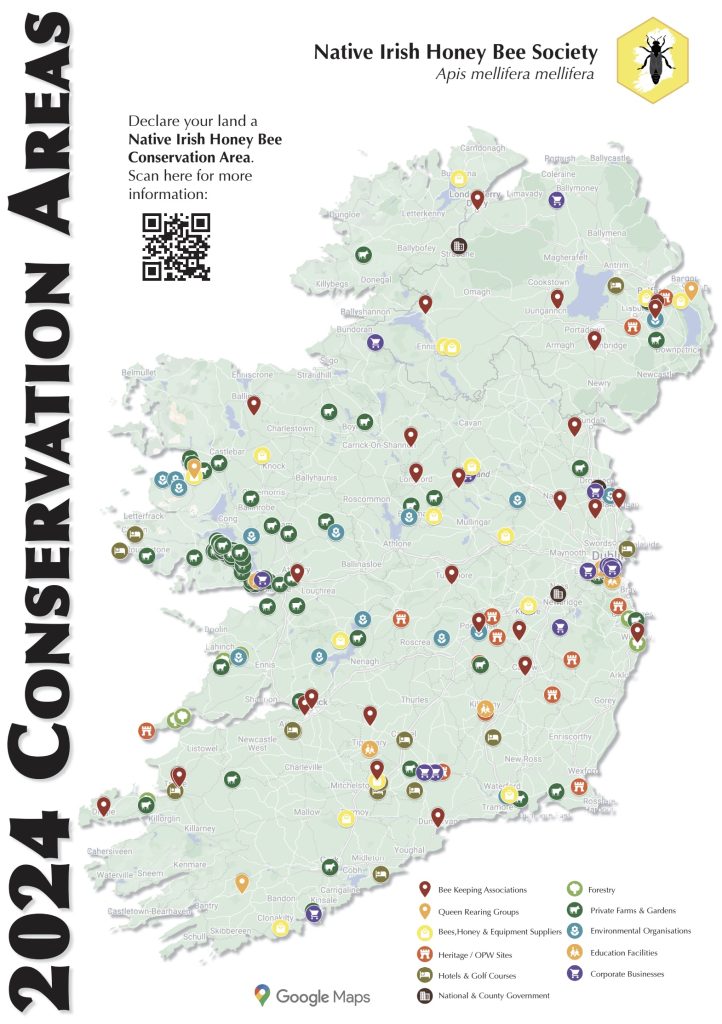
An Grianan
The Irish National Stud & Gardens
The Irish National Stud & Gardens is also home to two remarkable gardens: the Japanese Gardens and St Fiachra’s Garden. At the Japanese gardens, visitors enter an oasis of calm as they travel the ‘Life of Man’ path which traces the passage of a soul from birth to death and beyond. By comparison, St Fiachra’s Garden is an inherently Irish garden that symbolises the power of the Irish landscape. Predominantly planted with native specimens, St Fiachra’s Garden is home to an array of Irish wildlife.
From horses to horticulture, the Irish National Stud & Gardens is beautifully set on 850 acres of green rolling hills and offers an opportunity to become truly immersed within the heart of nature and provides a unique experience for everyone to enjoy.
In 2019, the Irish National Stud & Gardens established a honey bee apiary managed by Dr. Brendan Kavanagh, a retired University Professor and Zoologist. Presently, the apiary boasts 10 hives, producing over 150kg of honey annually. The native black bees (Apis melifera melifera) play a pivotal role in pollination, aiding the flourishing of flora around the stud. They primarily gather nectar from various trees and flowers, contributing to the vibrant ecosystem.
The Irish National Stud understands that its activities have both direct and indirect environmental impacts and sees the protection of the environment as an integral part of our everyday practises. The Irish National Stud is therefore committed to improving its environmental sustainability performance for the benefit of the people who live and work here, for the wider community and the surrounding eco-systems.

Lakeland Road, Hillsborough, Co Down
Nestled in the rolling Drumlins just outside Hillsborough in County Down is Lakeland Road, declared a NIHBS Conservation Area in 2024. Here a small number of hives, with Amm bees, are kept by Master Beekeeper, Dr. Phill Rogers. A similar number of apideas are run throughout the active season, mating locally, using Amm virgins grafted from the Belfast BKA’s Minnowburn apiary. The suitability of this native bee to the local forage and fickle weather is profound; their gentle nature, calmness on the comb and, compared to hybridised, or even worse, the so-called ‘Buckfast’ strain, their ease of management – containable within a single National brood box, makes them an excellent choice of bee. Their honey yield and overwintering is truly excellent.

Galtee Honey Farm
The Galtee Honey Farm was established in 1970 and is one of Ireland’s oldest honey farms. It is one of the few full time honey farms in Ireland, fully sustainable by providing consumers with honey only from their bees.
Killua Castle
Larchfield Estate – Lisburn
The Larchfield Estate comprises around 600 acres of Forest & Woodlands and is proud to partner with The Native Irish Honey Bee Society (NIHBS) to establish a conservation area for the native Irish Honey Bee. As a carbon-negative events and accommodation destination, we are dedicated to sustainability and protecting our local environment and wildlife.
Our journey with bees began about forty years ago when the Mackie family, owners of Larchfield, received their first beehive as a gift. In 2007, the hives were relocated to their current site, with local beekeeper Ken Baird graciously taking on their care.
Every year, we spin and jar our honey, which is now available for guests to purchase from The Old Piggery. It’s a delightful memento to remember their time with us.
Jaffhaog, Co. Meath
Killaloan Lodge Conservation Area
Killaloan Lodge is a 1930s extended timber-framed house situated on just over 1 ha on the south side of the N24 about 400m from the north bank of the river Suir. Most (80%) of the site consists of mixed habitats including lawn, wildflower areas, hedgerows, a seasonal pond and an orchard. It is surrounded on three sides by the Killaloan Farm Conservation Area (under different ownership) and bounded by natural hedgerows. There are 24 cultivated fruit trees (plums, apples, crab apples, pears, cherries, damsons and almonds (for the blossoms). There are willows along the pond margin. Other native trees include oak (3), ash (2), rowan (5) hawthorn (10), blackthorn (5), alder (5), birch (4), spindle (4) bird cherry (3) lime (1) hazel (8) and one large black poplar which has hosted an inaccessible colony of black bees for at least the last ten years. In season there are drifts of cyclamen, celandines, bluebells, dandelions (and a bed of mixed lavenders). There is a lime avenue about 600m from the western edge of the property. The site, apart from being surrounded by KIllaloan Farm CA, is about 1 km from Bulmers CA and four from Kilsheelan Village CA. It lies about 2 km from tracts of commercial forestry and upland moorland on the slopes of the Comeragh Mountains and Slievenamon. At present there are 4 colonies of Native Irish Honeybees on the site and the owner is enthusiastically supportive of NIHBS
Halseyrath Conservation Area
We have declared our small area of Halseyrath, Duncormick, a conservation area to help improve the quality of the Amm bees we keep on the property. We are now going to approach our neighbours, one of which keeps bees, and encourage them to join us in enlarging the Halseyrath CA. Our aim is to get the whole township declared for the betterment of all Amm bees in the area.

An t-Ionad Glas Organic College
An t-Ionad Glas Organic College Conservation Area The College is situated in Dromcollogher roughly equidistant from Newcastle West, Co. Limerick and Charleville, Co Cork. Its location is on the site of a former Technical School; and later a Vocational School. It consists of about one hectare devoted to Organic Gardens growing. This site produces a variety of vegetables, fruit and herbs using a range of cultivation methods. It has raised beds, polytunnels, a herb garden, tree nursery and more extensive cultivated areas. It has a poultry unit and an apiary which contains Apis mellifera mellifera. There is also a pond, an orchard with heritage apples and a willow coppice. It offers a range of nationally certified courses including organic enterprises such as food growing, sustainable living and beekeeping. Web: www.organiccollege.com
Butlers Family Farm
Butlers’ Family Farm is located at Harristown in Co Kilkenny and produces chickens, pigs and some cattle. It is not organic but is managed to be as self-contained and circular as possible. It covers about 40 acres in total. Five are dedicated to an Ash plantation with its associated understorey and there are about 0.5 acres occupied by a marshy “habitat” area. About 2 ac are planted with potatoes and the remainder is pasture.
The farm is bounded and subdivided by mature hedgerows with hawhorn, honeysuckle and gorse prominent. Animals and birds are free-range, pigs in outdoor pens, free-range chickens and a few cattle raised from calves to beef.
There are no hives on the farm, and no wild colonies on the property at the moment. There was a small apiary formerly maintained by a neighbour and bees -black bees-were a frequent sight foraging around the farmhouse. Since the apiary closed a few years ago honey bees are present in the vicinity but have been less obvious. The owners fully support the aims and objectives of the Native Irish Honey Bee Society
Killaloan Farm
Thornfield – Martry Honey



Armagh & Monaghan BKA
Armagh and Monaghan Beekeepers are in support of the Native Irish Honey Bee. We are a cross border Associaion with a 50/50 ratio of members. Our Apiary is based on the outskirts of Monaghan town where we hold training sessions for beginners. It is hoped that in the future we may have a queen rearing group. Our members are aware of the threat to the Native Irish Honey bees.

Retrieve Wellness & Ceramics
Retrieve is a small business owned by Kiera Lawthers based in the Causeway Coast & Glens offering wellness workshops, treatments and producing hand thrown, small batch ceramics. In 2019 Retrieve invested their profits back into their first log hive, an aptly designed home for honeybees, seeking to closely mimic the kind of home honeybees would choose for themselves in the wild.
The principle is simple, work with the native flora and fauna to support them within their natural environment. We know that habitat destruction means homes are dwindling for our native species and Kiera wished to do something to help combat this. The ethos is very simple and hands off with these honeybees – we do not take honey from them and nor carry out regular invasive inspections or apply treatments to the honey bees. We simply provide habitat and observe their behaviour from afar as they do their good work and live out their lives, thriving as they are designed to without human intervention.
We are delighted to have one of our hives in place at The Blackheath Pottery and Cafe located in the countryside of the Causeway Coast and nested in the grounds of the Georgian Blackheath house. Blackheath house was built in 1791 as a glebe house for the Parish of St Guaires Aghadowey, it was built on the instruction of Federick Agustus Hervey, Earl of Bristol, Bishop of Derry. The architect was Charles Shannon of Cork who was engaged by the Earl Bishop to build his well-known grand house at Downhill and Mussenden Temple, now managed by the National Trust. Moving to the present-day, Blackheath House is home to the four generations of the Belshaw family and hosts an art gallery and a stunning pottery workshop that can be viewed whilst sitting in the on-site cafe enjoying a hot cuppa and bun (or two!). They also offer a range of pottery classes and are just the perfect space to host one of our first conservation areas and within it a bustling little log hive full of happy bees, we are delighted to have the opportunity to collaborate with another small business in this way.
Retrieve now has three conservation hives in various locations and hope to build upon this, we are always open to collaborative opportunities to increase opportunities for honey bee habitat. We are proud to be recognised by the Native Irish Honey Bee Society as providing conservation areas for the bees.
We would welcome anyone to come and visit the hive at Blackheath. To find out more please visit; www.retrievewellness.co.uk/conservation
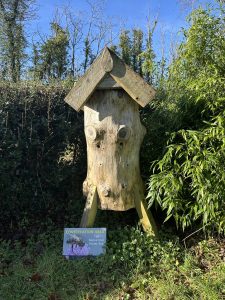
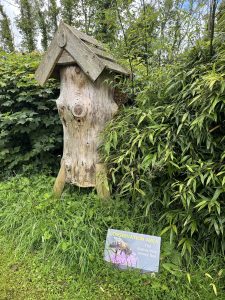
Sonairte
Sonairte is an interactive visitor centre promoting ecological awareness and sustainable living. The name Sonairte is derived from a middle Irish word meaning “positive strength”. Our Vision is to be a community hub enabling people to live more sustainably to address the twin environmental crises the world currently faces – the climate crisis and the biodiversity crisis. Our Mission is to be an educational centre which will protect and increase understanding of the natural environment, and will educate the public and schools in ways of conserving the environment
McIntyre Bees
I have always loved bees from an early age. Not sure if it was the colours of the Bumble bee that hypnotised my mind or the fact that something so small as a honey bee could produce large jars of golden honey which we ate on our toast as children.
I think as a child when my parents would have told us to eat up my sister and I did not realise the work the bees put into that honey ? I probably thought the bees worked in a factory where they jarred up the honey !! Little did I know later in life I would come to realise that they had their own little factory where each and every one has there own individual part to play. A healthy environment, raising brood disease free, calm & peaceful colonies in hives which can sit alongside us humans. Both parties can live in harmony and this is where the native Irish black honey bee comes in, it ticks all the boxes.
About 5 years ago, I planned to keep honey bees and I met Valentine Hodges who had a stall in Belfast with her lovely bee products. I asked her about the bees. She explained quickly about the conservation of the Irish honey bees and how her husband Chris was involved. They ran a course through CAFRES which would prove to be good for me.
I feel proud of keeping our native honey bee and I thank NIHBS for listening to me and taking the time to award my conservation area and give me signs and the right to display them and entrust in me to keep up the conservation work with the Irish black bee. I talk bees 24/7, strange the way life changes .
I have moved bees to another location along Strangford Lough. A beautiful area which I have worked hard in getting it ready – good foraging etc. I have 4 hives there and aimed at getting the best black Irish bees I possibly can.
Thank you NIHBS for your continued support

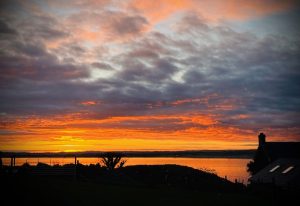

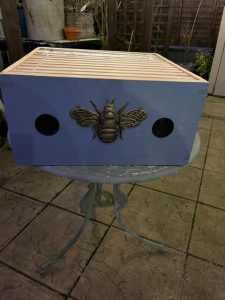
Camross Village
Ballinoe Bees
The Cashel Palace Hotel
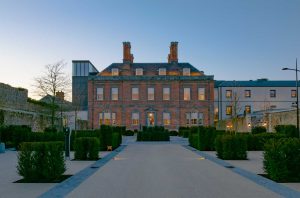

Teach Broga

Portlaoise Tidy Towns
“Love where you live” Our projects around the town are guided by our commitments to biodiversity, inclusiveness, and positive social change. Our work aims to foster and improve the social connectedness and sense of place in Portlaoise, building a community that is kinder, more socially connected and environmentally sustainable.
Stradbally Hall
Stradbally Hall, Co. Laois is one of the Historic Houses of Ireland, as it appears today dates from the middle of the 19th century. It is an enlargement in classical style of a Georgian House, which had been built in 1772 to replace a yet older residence. The foundations of this earlier house can still be traced a few hundred yards to the east of the present mansion. They lie among the trees that border the avenue leading from the
southern entrance to the demesne. The north front, with its massive pillared entrance, faces a broad stretch of parkland. The south front, of which the most remarkable feature is a lofty pillared pavilion, overlooks the terraces and gardens. Stradbally Hall has been the seat of the Cosby family since the reign of Edward VI.
The Irish Steam Preservation Society holds its steam rally there during the August bank holiday weekend, also on the grounds is The Stradbally Hall narrow gauge railway it is the longest established steam powered narrow gauge railway in Ireland. The railway runs on bank holidays and on request, except in winter.
Stradbally Hall has hosted the award winning Electric Picnic arts and music festival each year in late August/early September since it began in 2004. And also hosts a wonderful Christmas market, not to be missed.
Dunamaise Beekeepers Associations founded in 1975 replacing the previous Laois Beekeepers Association have an apiary on the grounds dating back to the early 60s, where they maintain hives of Native Black Bees (AMM) it is surrounded by mature forestry and parklands making it an ideal location for their primary training apiary.

The Low Country Native Irish Honeybee Association
The Low Country Native Irish Honeybee Association, known as Bog bees, was founded during the spring of 2020 by a group of Mid-Ulster beekeepers enthusiastic about the conservation and proliferation of the Native Irish Honeybee. The association established its first apiary in the bogland of Derryloughan and @Bogbees was born. Initially a queen rearing project involving a dozen beekeepers @Bogbees has expanded it’s project to launch a Voluntary Conservation Area in Derryloughan in association with the Native Irish Honeybee Society and launched in March 2023 working with Mid-Ulster Council and Lough Neah Partnership, @Bogbess secured funding, facilitating ground works and the positioning of a container unit close to the apiary for use in the grafting and rearing of queens, Nuc’s apidieas and the various equipment needed for the project were also acquired.
The genetic basis of the project were queens from Jonathan Getty and other local beekeepers renowned for their conservation and breeding of AMM native bees. The breeding programme is this year entering it’s fourth season with scores of native queens reared at Derryloughan spread across South Tyrone and Mid-Ulster, accurate breeding records are kept and selection is based on docility, productivity and hygienic behaviour, the bees retain the native traits of being frugal of flying and foraging at low temperatures in various weather and bringing in good harvests of honey in both the spring and summer flows, they really are a pleasure to work with.
Drone’s are crucial to the projects success and the use of drone comb to saturate the VCA with the right genetic material has paid dividends working in tandem with the remote location against the backdrop of the Lough, bait boxes on the peripheral act as sentinels for any swarms moving into the area and the group is working on bringing as many local beekeepers as possible into the fold to avail of the project thus reinforcing the dominance of native genetics. Thus @Bogbees publicly launched the Mid-Ulster VCA at the beginning of March confident in the several years of preparatory work, the event held in the nearby Washingbay Centre was well attended both by local beekeepers and with black bee enthusiasts traveling from across Ulster, this was very useful in terms of networking with likeminded groups and individuals and identifying beekeepers locally as prospective members. The key is dispelling the myths about the proficiency of imported queens and providing a source of both knowledge and genetics with which to meet the demands for queens.


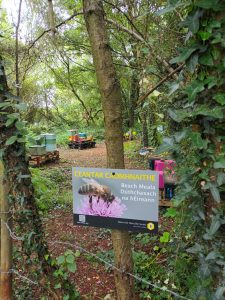
Loop Head Lighthouse
Loop Head Peninsula in County Clare is one of Ireland’s most spectacular and naturally beautiful locations. Perched at the tip of this narrow peninsula, with views of the Atlantic Ocean on one side and the mighty Shannon Estuary on the other, is Loop Head Lighthouse. It is the furthest point west on the County Clare coastline.
Loop Head Lighthouse is both a Special Protection Area (SPA) and a Special Area of Conservation (SAC) and now also a conservation area for our Native Irish Honey Bee.
As a Signature Discovery Point on the Wild Atlantic Way and, also one of the Great Lighthouses of Ireland, Loop Head Lighthouse is an historic and popular tourist destination. There has been a lighthouse on the Peninsula since 1670 and the current Lighthouse dates as far back as 1854, shortly
after the end of the Irish Famine. Visitors can take a tour of the lighthouse and the Lightkeeper’s Cottage. On a clear day the Twelve Bens in Connemara can be seen from the Lighthouse and to the South, the Blasket Islands can be spotted also. (Www.LoopHeadLighthouse.ie)
Loop Head is ruggedly wild but there is a variety of flowers for pollinators to benefit from here including our native meadowsweet, purple loosestrife, bramble, and wild honeysuckle. From April the cliffs are carpeted with cushions of sea pinks and these not only hum with insects but are a joy to behold. Non-native, but prolific and useful for our pollinators is the red fuchsia and montbretia that lights up the verges with swathes of bright orange in August. Loop Head is wild and spectacular, but nature has blessed it with a multitude of resources for our
native pollinators.
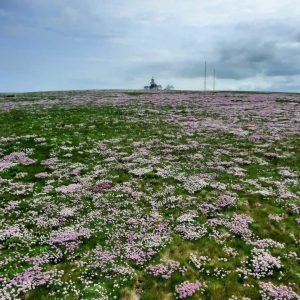

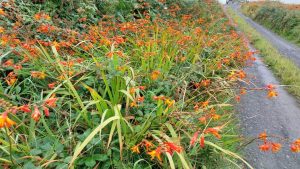
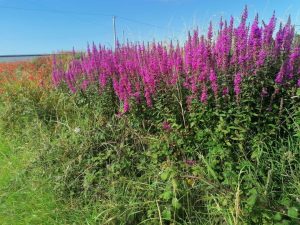
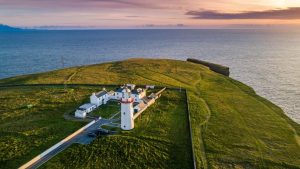


Lemon Family Bees
We are Lemon family honey bee’s, Mr & Mrs D Lemon. Based at the foot of the Divis / Blackmoutain BT13 area and our hives are located in our urban area garden & local allotment. We declared our area a NIHBS Conservation Area in Spring, 2023, although we have been beekeeping for 6 yrs. We are a family of six and our children help build the hives/frames and make lip balms and other products Beekeeper Darren goes into the local schools & Mens Shed projects to educate & share on bees. We have gifted our local Ambulance, Fire Brigade with honey for their tea breaks to give thanks for their services. We have several families that get honey from us for cancer family relatives to help boost the immune system. Our garden has three sets of eucalyptus for a more natural approach to varroa treatment and this is listed in the ingredients packaging. I hope this helps promote our great bee’s.
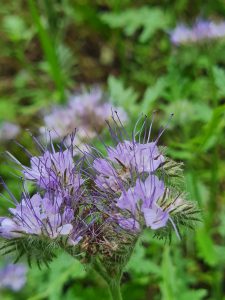
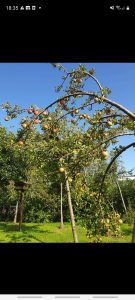

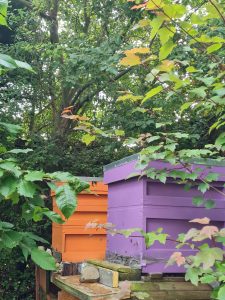

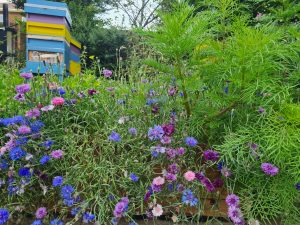
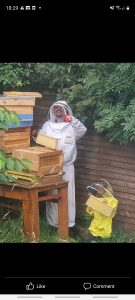
Royal Dublin Golf Club
Royal Dublin Golf Club is nestled in the dunes of Bull Island and is one of the oldest and most designated nature reserves in the country which is famous for its visiting winter birds and rare wildflowers. For some years now the club has been taking steps towards fulfilling its commitment to its internal and surrounding environment. One of the ways we have strived to pursue our goal is by allowing pollinators of all kinds to flourish within the course grounds.
We have been keeping native Irish honeybees since 2020 and currently have 2 active colonies that thrive in the acres of wildflower meadows surrounding their hives. After hearing about the plight of the native Irish honey bees we jumped at the chance to do our part in maintaining the genetic diversity of this fascinating creature and by joining the growing number of people involved with native bee conservation areas, we hope we can influence other establishments to do the same.

South Belfast Quaker Meeting House
South Belfast Quaker Meeting House has been on Marlborough Park North in South Belfast for nearly 60 years. It is a quiet residential location just off the bustling Lisburn Road shopping district. Our Meeting is small by most church standards with about 40-50 attending on Sunday mornings. Quakers have a strong commitment to the environment with a testimony to work towards sustainability. Our members are particularly keen to support eco initiatives.
Over the past two years, South Belfast Quakers have been updating our garden to attract more pollinators by planting lots of wild flowers in the bedding areas around the building. We have also stopped mowing areas of the lawn around the meeting house to let more plants grow.
We decided to declare our grounds as a Conservation Area for the Native Irish Honey Bee as we want to support our native biodiversity.
Declaring our Meeting House grounds is just a first step. We hope to extend the Conservation Area to include our Burial Ground later in 2023.
Belfast Quakers have encouraged local beekeepers to use our Belfast Burial Ground as an apiary for the Native Irish Honey Bee. The bees at this location benefit from being beside wonderfully tended gardens with lots of different flowers and plants to feed on.

Tribes Beekeepers Association
Tribes Beekeepers Association was founded on 9th April 2013 to promote the art of beekeeping in all of its facets and to raise awareness of the importance of bees in our lives. Our club has grown steadily and now, in 2023, we have over 100 members. We achieve the aims of our club through education, talks and hands-on experience at our apiary. Every year, we host classes for beginners and provide an active WhatsApp group for our members. Club meetings are held on a regular basis and guest speakers are invited to provide talks on a wide variety of topics. We are passionate about the preservation of our native black bee, Apis Mellifera Mellifera, and encourage all our members to support our native species. Our apiary is located in the beautiful, woodland grounds of the Brothers of Charity, Kilcornan, Co. Galway.
Green Fern Arts
Áine Nic Giolla Coda & Michael Minnis are visual artists and Lecturers in Fine Art at Limerick School of Art and Design, TUS. Their project ‘Green Fern Arts’ has been running since 2015 and is situated in Woodcock Hill, part of Cratloe Woods in Co. Clare. They have a large woodland garden of approximately two and a quarter acres. The site is bounded by a stream and contains a few remaining Sessile oaks, the ‘King of the Forest’ in these once ancient woodlands. There is also a fragment of temperate rainforest, with ferns, hazel and birch thriving within this microclimate.
About two years ago a large art studio was added to the property as the hub space for an ongoing art project which explores the woodland environment of Cratloe Woods. In this studio, classes, events, and talks are run for children and adults, using art and creativity to explore nature and the woodland eco system. They recently participated in Cruinniú na nÓg and ran workshops and an exhibition event where children were immersed in nature, observing leaves, cones, lichens, and animal habitats.
When they completed this build, they developed an area which is now a pollinator friendly garden, and this attracts many bird species and insects. This enables them to observe and point out to visitors and participants of classes the different types of pollinators there are in this area. There is a colony of Native Black Bees, very high up in the recess cavity of the roof of the house, which have been there for a least ten years. The couple have been monitoring the bees’ behaviors over these years through paying attention to their habits of swarming, collecting pollen and drinking from a small pond on warm days. This research employs photography, video, drawing, and painting towards the production of art works.
Instagram @greenfernart and E-mail to greenfernart@gmail.com
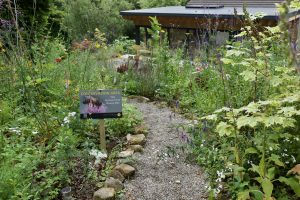
Emo Court House
Emo Court House is surrounded by beautiful gardens and parklands that make the perfect setting
for a wonderful family picnic in Ireland. The Laois estate dates back to the late 18th century and
was originally designed for the Earls of Portarlington.
The gardens and parklands of Emo Court House were first laid out in the 18th century and are a
glorious example of Irish formal gardens at their best. The estate features over 35 hectares of
naturalistic landscaped grounds, with formal areas, woodland walks, statues and a 20 acre lake,
making it the perfect spot for a family picnic.
The landscape contains formal lawns, a lake and woodland walks with beautiful trees and shrubs.
The extensive grounds, decorated with Greek sculptures, contain over 1000 different trees,
including huge sequoias, the world’s largest single tree species and shrubs from across the globe.
Visit Emo Court House and Gardens to see the two main areas of the gardens: The Clucker
contains rare specimen trees and glades of azaleas, rhododendrons and camellias, while The
Grapery is an arboretum with a series of pathways, each opening to vistas of the Slieve Bloom
Mountains and Emo Court House itself.
Located in County Laois, Emo Court House was designed by the architect James Gandon in
1790 for the Earls of Portarlington. A neo-classical mansion in County Laois, it’s located just
2.5km from Emo village and 7km from Portarlington Railway Station.
Emo Court House was acquired by the Jesuits in the middle of the 20th century. Functional
renovations were made to the estate before it was sold to Major Cholmeley Harrison, a former
London stockbroker, in the 1960s. Today the popular house and gardens have been restored to
their former glory and attract visitors from across Ireland and beyond.
Access to house by guided tour only. Guided tours available hourly.
Dunamaise Beekeepers Association maintain 6 hives of AMM bees in a walled garden area in
co-operation with OPW, and is used as a training apiary. There is also a hive of native black bees
in residence in one of the many trees on the estate.

Teagasc Athenry Conservation area.
Teagasc, Mellows Campus, in Athenry, Co Galway, is the home of the Teagasc Sheep research programme. On the research farm we have a project to enhance biodiversity (planting trees, creating hedgerows, building ponds) and see this as contributing to farm sustainability, livestock welfare and to the general environment of the campus.
And, importantly, these biodiversity enhancement measures also add to our overall KT and teaching resources. As part of this programme we are very happy to be a Conservation Area for the native Irish honey bee.
Fermanagh Beekeepers Association
Fermanagh Bee Keepers Association (FBKA) probably started just after World War Two. There were some beekeeping associations federated to UBKA in the 1940’s but very few details or minutes are available. There was probably a BKA in Fermanagh at that time but it appears to have fallen into abeyance until it was revived in the early 1990’s by several members [H.McC, AE, HM, EI, assisted by JG and CR]. Early meetings were held in the Railway Hotel, Enniskillen and an apiary was acquired at CAFRE (Enniskillen) about 1996 and a Club House (Meeting room) erected on the site by the founder members. The constitution of FBKA states the following as part of the aims of Fermanagh Beekeepers Association: To improve and advance bee keeping by (1)stressing the importance of using bees proven to be suited to local conditions. and (2) by discouraging the import of bees from outside the island of Ireland to help prevent the spread of exotic bee diseases and pests. The FBKA membership around 1996 was about 30 to 40 beekeepers. The newly established association was supported by several members of UBKA including Jim Fletcher, Bob Shaw, and Walter McNeill. FBKA promoted education from its foundation using the FIBKA exam system with the preliminary course starting in 1995 by Bob Shaw at the CAFRE site. The preliminary course has continued since then with Andrew Elliott as the lead tutor until Jackie Barry took over in 2022. Approximately 15-20 new beekeepers take the preliminary course each year and they are now using the UBKA course. The Intermediate Course was started in Enniskillen in 1997 by Charlie Nicholson and continued from 1998 by Ethel Irvine until 2020 when Brian Dane took over. The Intermediate Course has attracted bee keepers from Fermanagh, Tyrone, Cavan, Leitrim, Donegal and Sligo over the years, and this pattern has continued. There are currently about 20 members of FBKA with the Intermediate Certificate and about 20 others scattered across the neighbouring counties having studied at Enniskillen. FBKA has one member with full senior and FIBKA Lectureship and three members working to full Senior. The current membership of FBKA is just over 100 with a healthy proportion of younger members. The yearly programme consists of lectures and workshops each month from September until April. The summer programme takes place mainly in the apiary and includes regular practical sessions for students, queen rearing classes, an annual barbeque, a honey show and an away visit overnight to a friendly beekeeper willing to host us somewhere in Ireland. FBKA arrange bulk purchase of winter feed, anti-varroa treatments and honey jars for sale to FBKA members at near cost price. Sale of honey produced in the Association apiary, at the honey show and other events, raises income for the association funds. FBKA had members rearing some queens for their own use during the early years, but more formal queen rearing was started about 10 – 12 years ago. This continued at the apiary each year from about 2014 and FBKA were accepted by the NIHBS queen rearing programme in 2021/22. Approximately 200 virgin Queens were hatched during 2022 from an AMM queen provided by NIHBS. It is planned to continue this programme in 2022/23. Lough Erne Landscape Partnership (LELP) is a lottery funded scheme promoting the development and protection of the natural habitat of the Lough Erne area and FBKA is a partner in this group promoting natural pollination by AMM honeybees. The scheme assisted FBKA with funding to develop a study of feral or free living bees in the Lough Erne area. FBKA have about 20 bee boxes, of the design described by Thomas Seeley, located in wooded areas in the FBKA area. These are monitored remotely and managed by a FBKA member (DB). A subsidiary queen rearing programme by several FBKA members has produced a small number of queens from these free living bees. The oldest of these (TM) queens is in her third year and has prospered without any treatment for varroa. Two members of FBKA are associated with, and manage, three colonies of AMM bees at Mannok Park in Cavan near the Fermanagh border. This is an substantial industrial site with the colonies located on the site and managed by two FBKA members. The colonies produced enough honey in their first year to provide each of 150 workers on the site with an 8oz jar of honey to encourage interest in Beekeeping and new recruits to the preliminary programme. FBKA hope to promote and maintain a conservation area for AMM honeybees in the association apiary and the apiaries of FBKA members by continuing to teach the benefits of locally adapted native AMM bees and by distributing newly mated AMM queens, raised in our Queen rearing programme, to members and non-members in the FBKA area.
South Kildare Beekeepers Association – SKBA
Co. Louth Beekeepers Association
I think it must be over 10 years since Co. Louth BKA declared its area a VCA. It almost certainly pre-dated NIHBS. South Tipp BKA was the first, around 2010 and then I think East Cork and then Louth BKA and Connemara. I (Eoghan MacGiollaCoda) was involved a lot with conservation at the time with GBBG, which at the time was notionally an all-Ireland body. I gave a presentation to the SICAMM conference in Wales in 2012 on the conservation of Amm and mentioned it then. Incidentally, it was at that presentation that I coined the term “voluntary conservation area” to define an area, in which all the beekeepers agreed to keep only native honeybees, with the word voluntary recognising that for the time being, such a commitment would have no legal basis. Initially, I envisaged such conservation areas would apply to those areas “occupied” by BKAs. Since then, much has been done to expand this definition, bringing the whole concept to the wider public. Tom Hayden regularly produced maps in The Four Seasons of the various BKAs that had declared VCAs and Co. Louth was always included.
Cleggan Farm
The Farm does not keep bees itself but the heather is well used by Native Irish Honey Bees in the area. The role of NIHBS Conservation Areas where no honey bees are kept is essential to the development of “safe havens”. The undertaking that the landowner signs requires them to reserve their land, when it comes to Honey Bees, for only our Native Honey Bee.
Cleggan Farm is a peninsular between Cleggan Bay to the South and Ballinakill Bay to the North. It was established by my great-great-grandfather in 1852 and I am the fifth generation. It has spent much of its time as a somewhat private property, but over the past fifty one years I have taken a different attitude and approach and there is now a steady stream of walkers coming to ‘take the air’ and to enjoy the views.
Adare Manor
Set on an 840-acre estate, Adare Manor in Co. Limerick is one of Ireland’s leading five-star properties. The resort re-opened in November 2017 following an extensive restoration, refurbishment and expansion programme over a 21-month period. The largest restoration project of its kind in Ireland, the renovation and expansion honours the building’s architectural heritage as a Neo-Gothic masterpiece while incorporating the latest in contemporary luxury. Most notably, the expansion included a new 42-bedroom wing, increasing accommodations to a total of 104 guest rooms, a ballroom which can host up to 350 guests, and 2021 marked the launch of the brand-new Padel Club – a wellness and recreational facility nestled deep within the estate’s peaceful woodlands. The riverside demesne is now home to Ireland’s only spa concept by the globally recognised skincare brand, 111SKIN, helmed by one of the world’s leading cosmetic surgeons. The property is also home to elegant fine dining facilities including the luxury Michelin Star Oak Room restaurant, a championship golf course redesigned by award-winning designer Tom Fazio that will play host to the 2027 Ryder Cup, trout fishing on the River Maigue and a host of other estate activities, including falconry, archery, and clay pigeon shooting, which will intrigue even the most experienced travellers. Situated in the heart of picturesque Adare Village in Co. Limerick, Adare Manor is surrounded by medieval ruins, walled gardens and winding woodland paths and just 25 minutes from Shannon International Airport.
Our natural surroundings provide a platform for everything that we do and we are devoted to returning the same nurture and care to our beautiful home that it has so unconditionally granted to us. Providing a beyond everything experience to our guests and team members remains paramount to us and delivering this experience sustainably is at the heart of everything we do.
We have taken actions to minimise our carbon footprint along with various initiatives established across the resort to support a greener community and promote the natural growth and development of our environment.


Burncourt Community Council
Burncourt Community Council (BCC) is a community based voluntary organisation. A major element of the work of BCC is the provision and upkeep of Burncourt Community Hall. BCC works on an ongoing basis with the local clubs, school and various organisations in the area. The hall is available and is used on a weekly basis by Burncourt National School,Card Players,Dancing Classes, Flower Club, Parent & Toddler group, Drama Group,Sport Groups and others. BCC organise various events and Festivals throughout the year. These include Bealtaine,Summer Festival, Pumpkin Festival and provide the Hall for Drama Productions, Community Celebratory Events and as a resource for those who are bereaved with Funeral Teas. BCC also organise fundraisers for various charities. BCC is currently involved in two major projects – to Conserve and Restore Mountain Lodge in Glengarra Woods, a building which is of immense historical and architectural importance. 2023 will see an extension to the rear of the Community Hall with the potential of increasing the range of facilities available. Living on the doorstep of the renowned Galtee Honey, we are all fortunate to be aware of the tremendous work of the MacGillacoda family.The family’s willingness to take part in events , to engage in educational programmes with the national schools, to support the Mountain Lodge Conservation and Restoration Project , all ensure local knowledge of the importance of the Conservation of the Native Honey Bee. As a group and as individuals , we are privileged to be part of this work.
Mullyknock Apiary
For the last ten years or more I have worked with amm only and where possible, have sought to obtain swarms that are known to have come from wild living colonies, or to have my virgin queens located in areas where wild colonies exist and have little or no competition from managed colonies. Or I keep some of my own swarms – unless I give them to other beekeepers. The reasons have largely to do with the evident success of the wild colonies (and those derived therefrom) in living with or being able to manage varroa. I have not treated my hives for varroa, for almost ten years – with little or few losses and disease burden. The apiary is located in a rural area of mostly pasture, some unimproved meadows and grazing, raised bogs and some woodland. I also coordinate the Fermanagh Wild Bee project on behalf of our Association – the main aim of which is to support the wild honey bee population.
Lissan Lane Apiary
Lissan Lane is in rural Co Fermanagh about three miles north of Enniskillen. The apiary is located about the middle of Lissan townland and is well sheltered although on a high site 300 metres above sea level. It is owned and managed by Brian and his wife with 14 to 20 colonies. All colonies are Amm and replacement queens are from NIHBS queen rearing programme whenever possible. Brian started bee keeping in 2010 and progressed through the Preliminary, Intermediate and Senior FIBKA examination programme. The area around the apiary is partially wooded and grazing for cattle and sheep with virtually no arable farming. Bee products including honey (extracted, set, and cut comb) bees wax (candles and wax blocks) and mead are produced.


The Blackwell Household
The reason I got into beekeeping was to provide accommodation to native bees, when I had learned about them and the threat to their existence by imports. The small bit of honey I take from them is a bonus, albeit a big one. Of interest is that I have noted that all the honeybee swarms I have seen over the past year (in the vicinity of my home) have indeed been black bees. This has been very heartening.
Fossey Conservation Area
As an avid beekeeper and Public Relations Officer of Laois Beekeeping Association I understand the threats posed to the native honeybee by habitat loss, pesticide use, hybridization and disease, and it’s become clear to me that something needs to be done to protect this vital species.
That’s why I decided to take action and declare my land a native Irish honeybee conservation area. I keep several AMM colonies on my land and this year I am planting wildflowers and making my lands more pollinator friendly. I hope that my efforts will contribute to the conservation of these important pollinators and inspire others to take action as well.
Mayour Bees
I am new to beekeeping but have a lifelong interest in biodiversity & conservation. My fellow beekeepers in Westport Beekeepers Association are of great support & a font of knowledge & experience. My bees (AMMs) forage in a natural habitat of wildflowers & hedgerow with minimal intervention from me. I am happy to declare my support for the conservation of our AMM.


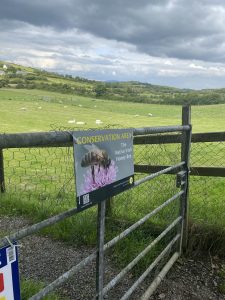
Inchydoney Bee Farm
My partner and I had the great fortune a few years ago to settle on a small subsistence farm at the centre of Inchydoney Island in West Cork, in the midst of amazing unspoiled natural Irish heritage. The coastal environments, dunes, woods and wetlands, in harmony with thoughtful farming, all combine into a beautiful and fragile ecosystem that we feel a duty to defend. We started with beginner beekeeping in recent years, and came to learn of the precarious position of many of Ireland’s native species when faced with invasive imports, particularly the threat to the native Irish honeybee, Apis mellifera mellifera.
The story of the native honeybee is the perfect narrative to energise citizens into action to defend what is precious on the island of Ireland. The story ranges from the critical role of native bee species in pollination of natural and agricultural growth, to the threat to Ireland’s cultural heritage where beekeeping is officially recognised, to the basic incompatibilities between unregulated trade versus the protection of local environments and livelihoods. We are proud to join the campaign to plant seeds of awareness of what we can all do to protect what is here, for us and for future generations.
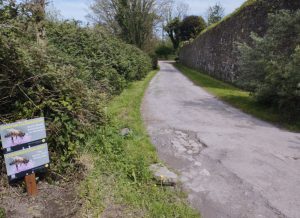
Rose Willow Cottage Apiary
Surrounded by Galway stone walls, this apiary is a small home apiary of 6-8 hives on private land. With both woodland and wild meadows in abundance, the bees have a huge amount to forage on nearby.
Paul Butler Household
I first dabbled in beekeeping at college but gave it up as being too interventionist. It was only in the last few years I realised that there are of course many ways of keeping bees and now I am happy to only keep Amm, do no treatments, few inspections and only sporadic feeding if any. (Actually I suppose I inspect all the time by watching the hive door activity!) I work as a forester and love to see the bees on trees and other plants I grow with them in mind. My farm is fragmented and I think this is an advantage as I can spread my hives out and I believe this is good for them.

Dromdúire
My name is Louise and I’m mad about our native little honey bee. I started beekeeping with my uncle Derek in 2013 with the native honey bee. Between us we have 6 to 8 hives on the go. Our approach to bee keeping is quite hands off, letting the bees do their thing.They are wonderful little creatures from the healing power of honey to helping the farmers in the fields and the list goes on. This is a small conservation area of 52 acres approximately. I am one of the next generation in this family to keep this land. When you’re raised on the land, the land feels like part of your DNA and feels very important to keep it healthy for the next generations. All the farms around me are farmed by relatives with nature in mind and some are organic. I rent out all but 2 acres to family. All of the fields are small and surrounded with lovely old hedges for wildlife. The names of the fields have been passed down the generations, Dromdúire is the name of the field we live in. In the little sally park there is a big old beech tree with a colony of bees in it that have been there for years. Every year I put a box out with excitement to try and catch a swarm. In the 2 acres that I keep around my house I have been planting all sorts of trees for bees and I’m the process of making a pond, changing it from a field, (nothing wrong with a field), but to a different haven for wildlife. The process brings me so much joy. Especially when I spy new things arriving. We have tadpoles this year and they’re like my new children. We all need to do our part to protect this little honey bee .Starting with a small conservation area and hopefully growing in years to come with neighbouring farms joining up . It would be lovely if all of Ireland became a conservation island for the native bee.
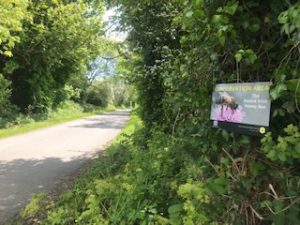
Woodfield House
Woodfield has been a family smallholding for the last 30+ years. Surrounded by forest and low intensity farming it offers a sanctuary for nature. In times past there were rare breed Tamworth and Large Black pigs, Black Welsh Mountain sheep and English Cuckoo marans all making it their home. Those are now gone but plans are afoot to establish some native black bee colonies on site in Summer 2023.
Killinchy and District Beekeepers Association Queen Rearing Group
We are a Conservation Area formed in 2022 endeavoring to raise awareness of and provide a safe haven for our Native Irish Bees Based in Finnebrogue Woods near Downpatrick in County Down. For further information, please contact Gwen Earnshaw or Sue Farmer at kbkasecretary@gmail.com
Cappawhite / West Tipperary
A group of about 15 passionate beekeepers are determined to keep West Tipperary a AMM Conservation area. It is a beautiful rural area and is based around the village of Cappawhite but extends to Tipperary Town, towards Golden and Dundrum. All the beekeepers are fully aware of the threats to the native bees from imports and are fully alert to such imports.
Kilkenny Castle

Kilkenny Castle & grounds are a Heritage Ireland site extending to fifty-two acres and situated in the centre of Kilkenny city. There Is a mix of parkland, woodland and meadows. We try to encourage as much biodiversity as possible, and we create habitat for all sorts of flora and fauna.
The Native Irish Honey Bee (Amm) is a unique black bee that we would love to help preserve. We intend to introduce only Amm bees to our site and the objective will be to increase the population in the park. We have been working with the Native Irish Honey Bee Society (NIHBS) to declare the safe haven so badly needed.
At present we have one National hive and a nuc of Amm ordered. Our ambition is to continue to increase this year on year.
There are also two “wild colonies” in the castle park which swarmed into Barn owl nest boxes, (made by our staff), and a further four “wild colonies” in the castle walls !! We have built a prototype log hive to our own design which we hope to hang soon and populate with another Amm colony.
We have declared a Native Irish Honey Bee Society (NIHBS) Conservation Area because we wish to create a protected area for our Native Honey Bee, which we believe deserves special conservation attention.
Fitzgeralds Woodlands House Hotel, Adare.
Fitzgerald Woodlands House Hotel and Spa is proud to partner with The Native Irish Honey Bee Society (NIHBS) in establishing a conservation area for the native Irish honey bee. As a hotel committed to sustainability the Fitzgerald family recognizes the vital role that bees play in our ecosystem and is dedicated to promoting environmental stewardship and biodiversity on its grounds.
This initiative reflects the hotel’s commitment to environmental sustainability and preservation of the native Irish honey bee population. The native irish honey bee has come under threat from imported diseases and hybridisation so we will create a conservation area which will be a designated space to support the welfare and preservation of the Native Irish Honey Bee.
The hotel’s Organic garden, Marys Organic Garden is a project of passion for owner Mary Fitzgerald and supplies the hotel’s kitchen with organic fruits, vegetables, and honey. In partnership with the NIHBS, the onsite apiary will be expanded to house native black honey bee hives. The honey harvested from these hives is used by our guests and for treatments at Revas Spa.
Mary Fitzgerald, the owner of Fitzgeralds Woodlands House Hotel and Spa, said, I am thrilled to be working with the NIHBS to help protect the native Irish honey bee. Our garden and honey bees is a project close to my heart, and it brings me joy to see it thrive while also helping to promote sustainability and education in our hotel operations. This collaboration with NIHBS is a significant step forward for Fitzgeralds Woodlands House Hotel and Spa in its mission to promote environmental sustainability and conservation.
The hotel is committed to preserving the beauty and nature of its 30-acre estate and continually seeks out innovative ways to promote sustainable tourism. Our hives are also a very popular feature for classes and tours in our garden for our junior and senior residents.Guests and visitors are welcome to explore the walking trail and to visit and observe the native irish honey bee hives, which are an integral part of Fitzgeralds Woodlands House Hotel and Spas commitment to sustainability.
Take a look at how our website is helping the Native Irish Honey Bee Society, https://www.woodlands-hotel.ie/home/honey-bees
Irish Cement Plant Drogheda

Irish Cement has several Amm hives on their 800-acre site and is committed to their biodiversity behaviours to the Native Irish honey bee.
The Bee Barn
We run a small business here and are situated on the shores of Lough Sheelin in South Co. Cavan and declare the areas of Castlerahan, BallyMachugh and MountNugent. We have been involved with the NIHBS Queen breeding group scheme . I am the Administrator for the Breffni Bee Breeders group . At our Bee Barn we are open to groups, for example schools, garden clubs, Mens sheds and anyone interested in learning about bees & beekeeping . We have a big interest in promoting the native Irish bee & we try to educate possible new beekeepers on its importance”.
Carlow BKA
Heywood Gardens, OPW, Laois.
South Tipperary, The Apple Farm
Con Traas owns and operates The Apple Farm, near Cahir in Co. Tipperary. The farm consists mostly of fruit crops, including strawberries, raspberries, cherries, plums and apples. All of these are insect pollinated, and so bees are a very important component of crop production on the farm. Also on the farm is a juice-production business, as well as a farm shop, and wildflower area, the latter of which provides habitat and a food source for many beneficial organisms.
Coolnahinch Conservation Area
” Living lockside on the Royal Canal, surrounded by Farmland, Bog & Forest is an ideal place for me to keep my bees. The Royal Canal Greenway is nearby and I hope to raise awareness regarding the plight of the Native Irish Honey Bee to those passing by. I am a hobby beekeeper with nine colonies and like many I am battling against hybridisation caused by swarms of non-natives, Buckfast’s and so on. My intention is to use locally sourced Native Queens to produce lots of Native drones and get my Apiary back to where it used to be. I am going to distribute any surplus Native Queens to other local beekeepers.”
Digges BKA Conservation Area
Digges Beekeepers’ Association had its first meeting in the Autumn of 2009 in the Old Hall in Fenagh, it is now ‘The Monk’s From the start it was dedicated to the memory of Rev. J.G.Digges, widely regarded as the father of modern Irish Beekeeping. He lived and worked in the area. Regular meetings were set up in 2010 in the Teagasc Centre, Mohill. Most members come from the South of Leitrim.
Eamon Tubman kept the show going organising meetings with speakers and giving us the benefit of his many years of experience. He also gave us an appreciation of our Native Irish Honey bee as did Colm Brangan who brought the idea of a Conservation Area for the Native Irish Honeybee in this location to our AGM in 2019. Eamon and Colm stay in our memories, and we are very grateful to both for their efforts.
All of our members work with the Native Irish Honeybee Amm to the best of their ability, and we have started the Queen Rearing Project this year with the support of NIHBS and hope to improve our skills next season. With a bit of luck, we will be able to contribute to the biodiversity in our area.

Rev. J.G.Digges
Fingal North Dublin BKA
Gortnagown
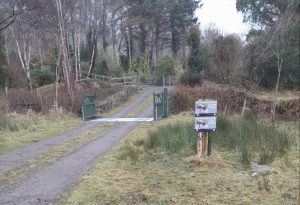
Gortnagown Conservation Area, based in Glencar Co.Kerry, is the brainchild of Joseph & Rosarie McGillycuddy. The NIHBS Conservation Area comprises woodland of about twenty acres and Joseph is working on a regeneration scheme for the woodland. They are located on the south-eastern shore of Caragh Lake. They have 4 hives which they hope to increase over the next few years. They have always kept a few hives in Gortnagown & they have been part of the McGillycuddy ancestry for 4 Generations. They are very interested in the conservation of the Native Honey Bee, and realise & appreciate the importance of the Native Honey Bee
Modomnóc CA

Encompassing Garristown, North County Dublin and some surrounding townlands in an approximate 15km radius.
Modomnóc is fabled to have travelled by sea between Wales and Ireland bringing swarms of bees on the mastheads. He was also able to achieve all this without being stung !! Modomnoc’s talking to his bees is in keeping with an Irish folklore custom of ‘Telling the Bees’ which ensures that the bees do not feel any offence due to exclusion from family affairs and so will remain with the hive. It was believed that if one didn’t tell the bees of a wedding, a birth, or a death they would take offence and leave.
Co.Cavan
This encompasses Ballymachugh, Castlerahan and Mountnugent areas. Amm breeders and keen supporters of the QRGs. The challenge was to declare irrespective of local Association because they strongly believe that the CA’s needed support.
West Co. Waterford
South Tipperary
North Co.Kildare
Killinchy
Co. Offaly
South Co. Laois
Regina Rogan
I have been a member of the Westport Beekeepers Association (WBKA) since 2012.
I have a keen interest in Native Habitats and Biodiversity, which first drew me to beekeeping.
I have also served on the WBKA Committee as Club Secretary, and have seen at first hand the dedication to passing on learning and expertise that comes with beekeepers sharing their skills and giving freely of their time to help others.
It is extremely important to save the Native Irish Honey Bee from further hybridisation, and I would like to do whatever I can to support NIHBS in this work.
Shehy Mountain Conservation Area
“Shehy Mountain Conservation Area is a group of five keen beekeepers with six separate apiary areas under the umbrella of the Dunmanway And District Beekeepers’s Association. The groups aim is to both keep and breed locally adapted native Irish honey bees. The Dunmanway BKA are also involved with the NIHBS queen rearing scheme and through this the group hopes to expand its reach gradually over a much wider area of ground and in this way play a part in conserving and improving our native Irish honey bee”
The conservation area is made up of five town lands with an area of just over 2500 acres. The land is mostly marginal with some fertile farmland but also bog and old woodland. The farms tend to be beef and sheep so not intensive. All in all, a fantastic place to keep bees.
The bees kept by the group are mostly black bees but there are some hybrid bees in the areas surrounding the conservation area. Hopefully by having quality native queens available locally we’ll solve this problem.
South Kildare Beekeepers Association SKBA

On the 19th of March 1930 the South Kildare Beekeepers Association was founded.
South Kildare was the first Beekeepers Association in Ireland to establish standards for bottled honey. The Policy of producing a high grade bottled honey rather than sectioned honey was adopted by the Association. Honey from the local hives was bottled with a label bearing the name of the Association and a map of Ireland with an individual number allocated to each honey producer. Honey from South Kildare was despatched to all parts of Ireland and Jacobs, the biscuit manufacturers and the Monument Creameries, both of Dublin, were buyers of substantial quantities of the product.
However, the success of the early years was not maintained and in 1945, largely due to the low prices then prevalent for honey and the high cost of beekeeping equipment, the Kildare Beekeepers Association went into decline.
Michael Moore of Athy was responsible for re-activating the Association following his attendance at a week-long Beekeepers Courses in Gormanstown in 1962 and 1963.
SKBA is still going strong in 2022 with 70 members and our association apiary produced an excellent honey harvest this year. We are strong supporters of the Native Irish Honey Bee, Apis mellifera mellifera; in 2018 we voted to make South Kildare a Conservation Area for Amm with the aim of conserving, protecting and improving our local bees.
SKBA’s annual beginners’ course is always popular and some members have progressed to being actively involved in NIHBS queen rearing groups. We look forward to celebrating our 100th anniversary in a few years. “
Boomtree Bees Conservation Area
Mick Verspuij grew up in Wellseind, a little place along the river Maas in the Netherlands, He was always out in nature. From a young age, he was fascinated with the environment around him, particularly trees. He was intrigued by how adaptable they are, their different shapes and structure, and how useful they are to both wildlife and humans. This led him to go on to study Forestry and Landscape Management in Velp, Gelderland, NL. After completing his studies, he came to Ireland in 2001 where he started a forestry contracting business in Galway. Throughout these years he became increasingly aware that things needed to change. Hedgerows were disappearing and biodiversity on farms was diminishing because of the intensification of farming practices. At this point, he changed career and went into organic farming. Here it became clear that bees were vital for the pollination of crops. With that in mind, he attended a beekeeping course and got a hive of bees. It soon became apparent to him that conventional beekeeping is more focused on honey production rather than natural bee life. He began to research and found that there were wholesome ways of beekeeping which in turn led him to explore how bees live in the wild. Given the increasing loss of wild habitats, he looked at ways to mimic their natural nesting sites in cavities in trees.
The mission is to help with the conservation and rewilding of the native honeybee through habitat creation and development. Boomtreebees make log hives which are suitable habitats for honeybees in the Irish countryside. At Boomtreebees education is a priority. Their aim is to educate schools, community groups, and others about the importance of the honeybee in our environment and what can be done to secure their future.
Killucan Honey Conservation Area
” Killucan Honey is a producer of locally harvested multiflora honey from Native Irish Honey Bees in Killucan, Co. Westmeath. The bees are Apis mellifera mellifera and the operation consists of 70 hives in different Apiaries across Westmeath and North Meath. The bees forage in natural habitats, isolated meadows, and within a special protection area along the Royal Canal. The honey is unique in flavour due to the foraging on Horse Chestnut, Dandelion, Willow, Sycamore, Mountain Ash, Clover, Blackberry, Raspberry, Wild Honeysuckle, Heather, Ivy, Willow Herb, & Meadow Sweet. The honey produced is raw and retains all the local pollen. The honey is never heated so maintains the enzymes usually found in natural raw honey
The Native Queens are raised through a careful Queen rearing regime for docility, honey production, comb building, & hygiene. Killucan Honey works closely with NIHBS, the Native Irish Honeybee Society, and Queen Rearing Groups. This helps to protect and preserve the native black honey bee which is under threat from diseases brought into the Island by imported Queens & bees. Also, it is increasingly difficult to rear Queens whilst coping with the threat of hybridisation spoiling the genetics of our native honey bee. This causes undesirable traits, and a lot of work goes into conservation through the selected and isolated locations of Killucan Honeys’ Apiaries.”
Irish Seed Savers Conservation Area
‘The Irish Seed Savers Association (ISSA) have made a major contribution to the protection and enhancement of nature on farms, gardens and across Ireland for over 30 years.
ISSA conserves Ireland’s threatened plant genetic resources and maintains a public seed bank of over 600 varieties of seed. They preserve heirloom and heritage food crop varieties that are suitable for Ireland and local growing conditions, contributing to the nation’s food security. They provide a unique service to the nation in terms of supply of organic heritage seeds and apple trees. The 20-acre farm, gardens, and visitor trail at Capparoe, Scarriff, Co. Clare is an inspiration, ably demonstrating intelligent land management and best practice in organic farming and farming for nature. They supply seeds of vegetables, grains, herbs, and edible flowers, as well as apple trees the progeny of which, thanks to ISSA, adorn many an orchard across Ireland today.
Irish Seed Savers are committed to preserving the local genetic character of our indigenous black honeybees through a hands-off bee-centered approach. By creating appropriate habitat opportunities for these boreal insects to thrive and to improve their resilience to the many, many challenges they are facing.’
Blackwater Honey Conservation Area
We are two brothers, John, and Andrew Shinnick, and we’re declaring for the Fermoy area, Ballyhooly and Blackwater valley. Blackwater Honey use traditional and modern beekeeping methods in order to help the conservation of our native honeybee whilst aiming to produce the highest quality premium Irish Honey for sale. Blackwater Honey is Ireland’s Most Awarded honey and is proud to be a leading partner in the conservation efforts of the native bee in conjunction with the NIHBS.
Kingdom BKA Conservation Area
Kingdom Beekeepers is a FIBKA affiliated Association based in Co. Kerry comprising around one hundred members. They range in skill levels from novice to expert. During the year we hold online and face to face Beginners Sessions and it is great to be back together at our Training Apiary in Tralee. We hold regular Club meets, with interesting Speakers, and also recently formed a NIHBS Queen Raising Group which is proving very successful. We had been interested in declaring a NIHBS Conservation Area for the Native Honey Bee for some while but this year we decided was the year !! Our mind turned to other Kerry Associations and we put together a joint declaration for World Bee Day with West Kerry Beekeepers and IBA Collis Sandes. It was great to co-operate. It was an easy process to declare and our membership was very enthusiastic in their support of Amm. We fully support the effort that NIHBS is making with regard to the protection of our Native Honey Bee and its campaigning efforts to ban imports of Honey Bees protecting our Native Honey Bee from imported diseases and further hybridisation
Pocket Forests Conservation Areas
Good things in small packets: Pocket Forests declare Conservation Areas for the Native Irish honey bee
Ashe Conrad-Jones
Pocket Forests is a nature-based social enterprise bringing small native forests to urban areas. We help to reconnect people with nature and empower local communities to tackle the climate and biodiversity crises on their doorsteps. We have planted forests with schools, universities, fire stations, GAA clubs and community groups. At the moment we are active in 70 sites in 7 Counties and in Northern Ireland and have worked with over 200 students
People gain a sense of pride and empowerment by being involved in every step of the creation of these healthy green spaces. Pocket Forests can help alleviate anxiety and provide havens for life, learning and mental wellbeing. We create memorable experiences for people preparing soil and planting their own forests which become thriving ecosystems that they can enjoy watching grow and develop. Among the native species planted are Rowan, Crab Apple, Guelder Rose, Spindle, hazel and Hawthorn
Pocket Forests is the only organisation regenerating soil and planting highly diverse small native forests in Dublin city. We have worked with more than 100 students with their teachers and planted over 1500 native trees and shrubs, repurposing tonnes of urban waste into healthy soil. Pocket Forests has made a big impact with more than 30,000 visits to our website, interviews with national media including The Irish Times and RTE and have built an engaged and growing following on social media.
We have a holding nursery and community awareness space in the Digital Hub on Thomas Street.
Rare Ruminare Conservation Area
Clive Bright produces and direct-sells the finest 100% pasture-fed organic beef and rosé veal through his company Rare Ruminare. On his farm in south Sligo, Clive uses Holistic Planned Grazing to manage his animals and diverse grassland. He has a keen interest in agroforestry and is actively increasing tree cover to create high welfare, resilient habitat for his livestock, pollinators and all wildlife.
Clive is dedicated to making space for our native black bees. He believes they are best adapted to our environment and that preserving their genetics is vital to ensuring the pollination of food crops now and in the future.
Manna Farm Conservation Area
Manna farm is based in the Gleann na ngealt Valley on the Dingle peninsula where we grow a variety of produce for our own farm shop. Organic Store which can be found on the Island of Geese, Strand Street, Tralee.
It is a fully certified Organic Shop, selling a wide range of delicious organic fruit, vegetables and organic wholefoods.
With produce from our own farm, and other local organic farms, Manna is a shop with a difference. It is ALL about the taste. At Manna we sell all kinds of organic fruit and vegetables, some depending on the season. We bring in as much stock as possible from the local organic farms, including our own. And we have a buying policy to get our non-Irish stock from as close to Ireland as possible.
Organic food and caring for the environment we live in is not just a job for us – it is our life, we live it every day – on the farm, in the shop and at home.
We have local honey from many local beekeepers and we really see the importance of protecting our native Irish bee to ensure we have honey and healthy bees into the future. This is why we are delighted to work with NIHBS to set up our farm as a conservation area for the Native Irish Bee.
Brookfield Farm Conservation Area
Ailbhe Gerrard is the farmer and beekeeper behind Brookfield Farm. After working and living in Dublin and abroad for many years she returned to Brookfield farm beside her family home. Ailbhe studied sustainable development in University College London, and organic farming for three years in the renowned Scottish Agricultural College (SRUC). She was honoured with a Nuffield Agricultural Scholarship, and lectures at Gurteen Agricultural College. Driven by her vision of bringing agriculture back to its sustainable roots; producing good food for people. Ailbhe has farmed Brookfield Farm for over ten years, growing skills, developing new ideas and making collaborations with skilled farmers, apiarists, and consumers.
As well as farming the land Ailbhe was inspired by the views and rich land of the farm, she set out to create entirely natural, traditionally handmade gift products from the honey being produced, including beeswax candles and gift boxes. The candles are dipped + hand poured often scented with botanical essential oils.
Farmhouse Bees & Trees Conservation Area
We are Pat & Fiona McCormack of The Farmhouse Bees & Trees Ltd, and with the help of our two children, we keep native Irish honeybees in a small apiary between the banks of the royal canal and the River Inny near Abbeyshrule, Co. Longford. We both trained as horticulturalists, during Pat’s studies he completed a course in beekeeping under the instruction of Philip McCabe in An Grianan, Termonfeckin.
We got our first hive of bees from Fiona’s Aunt, who was retiring from beekeeping at the time. Beekeeping has been in the family for at least 3 generations, that we know of. In the last few years, we have increased the number of colonies we keep & have diversified into queen rearing & nuc production. The honey produced by our bees is coarsely filtered to retain all the good antibacterial & antioxidants. We produce Spring honey, summer honey, Heather honey & Ivy honey.
Parliament Buildings Stormont Conservation Area
“Parliament Buildings, Stormont, declares for the Native Irish Honey Bee !!
Parliament Buildings, Stormont, is delighted to announce its support for the Native Irish Honey Bee by declaring a NIHBS Conservation Area!!
The Native Irish Honey Bee Society, NIHBS, was established to promote the conservation of Apis mellifera mellifera throughout the island of Ireland. The Society strives to raise public awareness of our native honey bee and its importance, and acts in an advisory capacity to groups and individuals wishing to promote and preserve it.
Parliament Buildings is home to the Northern Ireland Assembly and the beekeeping idea was first mooted with the Assembly back in 2018. The Soroptimist Belfast Club wished to install an Apiary here. The Soroptimist Belfast Club is part of an international organisation whose work is linked to sustainable development goals whether it is local, national or International. All of their projects work towards ending poverty, eradicating hunger, providing education for all and preserving the environment.
In March 2019 an apiary was installed in the grass bank at the Upper West car park of Parliament Buildings and five members of staff from the Assembly trained successfully as beekeepers. They are mentored by the appointed beekeepers and work together to manage the bees.
There are currently three Congested Districts Board, CDB, hives with native black Irish bees, and two nucleus colonies (miniature colony of bees), complete with combs of honey, pollen and a queen), in the apiary. They are cared for by the Stormont bee keepers and VeesBees. Congested District Board (CDB) Hives were devised in Ireland in 1890 to suit the particular wet and cold Irish weather by CN Abbott, technical advisor to the Irish Congested District Board and a member of the Abbott Brothers Company who manufactured the hives. The three we have were made in 2014 using the original Abbott Brothers plans and amended for today’s use. The wood is from a 100 year old (in 2014) cedar tree which fell in County Wicklow and the hives were hand-made in Donaghadee. The plan is to use these hives to educate staff, visitors, and school groups on the importance of bees within the eco system and to raise awareness of native honey bees and native hives. We feel that by highlighting the traditional CDB hives and the history behind their construction it enhances the educational aspect of the apiary.
The Assembly works in partnership with several organisation’s and we are particularly keen to highlight the bees and their significance to the Eco Schools when they visit the building. There were some concerns initially with installing the apiary as people were afraid of visitors and staff being stung. These were addressed by educating staff and, following iinstallation, there have been no real issues.
Working with our communications team, VeesBees, NIHBS and others we plan to install signage at the apiary to mark the conservation area and then publicise it on social media and the external website.”Fitzgerald Woodlands House Hotel and Spa is proud to partner with The Native Irish Honey Bee Society (NIHBS) in establishing a conservation area for the native Irish honey bee.
Plezica House

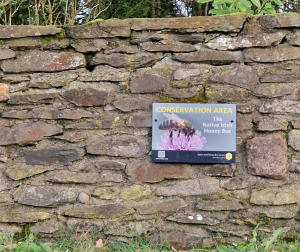
I am a small scale beekeeper/conservationist outside of Dunlavin, keeping bees in several apiaries in the vicinity. Plezica is my home apiary, we have 10 acres of fields, woodlands and some ‘wilderness’, an area that used to be part quarry and has now been left to rewild for a number of years, covered in gorse, brambles and multitudes of wildflowers in the summertime. We are also in the process of reforesting more parts of our land, partially groundcovering and partially in small dense miniforest projects. I keep up to 5 or temporarily max 6 hives here, mostly in Warre hives, trying to keep my bees as naturally as possible . I am regularly assessing my bees to hopefully keep them as pure AMM as possible and was recently delighted to find that the latest genetic study is in line with this ambition. I would like to gradually make more people aware that we only have 1 native species of honeybee in Ireland and get conservation areas spread to other places that I keep bees in .
Ultan Duggan – Private Dwelling
This NIHBS Conservation Area, located in East Waterford is located approximately 400 m from the River Barrow And River Nore SAC, a site of international conservation significance, protected under EU Legislation. The Conservation Area itself is a private dwelling consisting of improved amenity grassland, sections of naturally occurring wildflowers, a wildlife pond and a horticulture tunnel; encased on all sides by a variety of well established native trees and shrubs such as Ash, Birch, Scots Pine and Bramble. It is a quintessential countryside home.
At present, there is no beekeeping being undertaken within the site. This however, is to change in the near future, with plans to manage Apis mellifera mellifera populations for conservation and biodiversity enrichment purposes. This is all part of the wider goal of supporting native biodiversity throughout the site. This will include increased areas of native wildflower coverage, additional wildlife ponds to support invertebrates, plants and mammals, the implementation of bat and bird boxes and more. In keeping with the theme of conservation, this small site actively does it’s bit to reduce instances of environmental pollution through a strict avoidance of herbicides and pesticides, monitored use of fertilises or other growth enhancing products, the recycling of nutrients through the use of a compost bin and a strict no tolerance policy on invasive plant and animal species.
This biodiversity ‘project’ is one of passion as a member of this household is a practicing ecologist and wildlife biologist who fully understands the importance of native biodiversity and the requirements to support it. This ~ 1,450 m2 private site located in the countryside of East Waterford is an excellent example of how a seemingly insignificantly sized parcel of land can act as a safe haven for Apis mellifera mellifera in Ireland; promoting conservation through awareness, sustainable practices and a genuine desire to conserve one of our vital genetic recourses. It is hoped that the designation of this small Conservation Area will inspire others, especially those who are on the fence about approaching NIHBS, believing that their small town garden is no good to the cause. Every area counts, no matter how small and each square meter of area will further strengthen our only native honey bee’s foothold in Ireland

